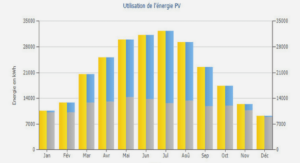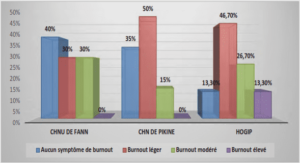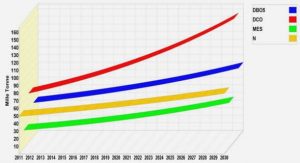Incertitudes de la pluie des modèles régionaux
de climat à l’aide d’un modèle de culture
Measures of spatial coherence
Is there a predictable, large-scale pattern in the occurrence of dry spells? To answer this question, STDATEs are associated to the durations (L). To obtain uniform sampling in time, the dates in the Julian calendar are rounded to the pentad in which they fall. When there is no extDS, the pentad takes the value zero (i.e. L = 0). This provides a regular time series of L in MJJ, ASO of each year at each raingauge. The average seasonal cycle of L, at pairs of raingauges, are then correlated. Examples of seasonal cycles of L at individual raingauges (local dry spells) are given by Salack et al. (2012). A correlation matrix is computed using the actual durations (L) at pairs of raingauges. Likewise, raingauges’ coordinates (longitude and latitudes) are used to compute the matrix of distances across pairs of raingauges. Spatial coherence is found by testing the statistical significance of the correlations between pairs of raingauges (inter-raingauges correlation, hereafter). In each country, the similarity of the inter-raingauges correlation coefficients is assessed with respect to the distance between pairs of raingauges (Fig. 6). The scatter plot of correlation coefficients is presented with respect to the distance between pairs of raingauges (km) for both MJJ (Fig. 6a, ASO Fig. 6b). In MJJ, a high density of correlation coefficients significant at 95 % level (r = 1 to r = 0.5) are depicted between 0 and 150 km inter-raingauge distance. This shows that DS occurring in MJJ can be spatially coherent from a given raingauge up to other surrounding raingauges over a radius of 150 km. Beyond this spatial extent, the high correlation coefficients seen on Fig. 6a are due to long-term climatological analogues between raingauges. In ASO the spatial correlation of DS occurrence exhibits lower spatial coherence, limited to approximately 70–100 km: significant inter-raingauges correlations (r = 1 to r = 0.5) decrease more rapidly with inter-raingauges distance (Fig. 6b). This sub-seasonal period includes peak and retreat phases of the rainy season in both Niger and Senegal. Therefore, a situation of mesoscale extDS (DS3 category) can possibly be followed by isolated convective rainy days at some stations, especially in the regions above 800 mm/year.
Relationship between extreme dry spell occurrence and SST anomalies
It is well established that rainfall variability in the Sahel is closely linked to SST anomalies (Vizy and Cook 2002) with the Atlantic, Pacific and Indian Oceans all playing a role (Folland et al. 1986; Janicot et al. 2001; Giannini et al. 2003; Mohino et al. 2011). Figure 7 shows the regression between global SSTs and the regional occurrence index (ROI) of extreme dry spells (DS4 and DS3) in each sub-season. Strong anti-correlations are found between the occurrence of the DS4 category of extreme dry spells in MJJ and SST anomalies in the entire tropical Atlantic. Conversely, the occurrence of the DS3 category in ASO is anti-correlated with SST anomalies in the subtropical north Atlantic only. A strong, widespread correlation is found between the occurrence of extreme dry spells (DS4, DS3 categories) and the equatorial Pacific and Indian Oceans (global tropics, henceforth). We hypothesize as follows. Global tropical mean sea surface temperature sets the vertical stability globally from the top down through deep convection (Neelin et al. 2003; Chiang and Sobel 2002), while the tropical Atlantic modulates it locally from the surface up through (a) (b) Fig. 6 Inter-raingauge correlation coefficients w.r.t. inter-raingauge distance. a In the MJJ sub-period, the spatial coherence is shown by the dense significant correlation coefficients (0.6–1) from 0 km up to *150 km. b In ASO sub-period the spatial coherence is limited to 0 up to *70 to 100 km Oceanic influence 123 Author’s personal copy atmospheric moisture supply (Giannini et al. 2008). Warmer global tropical SSTs set a higher threshold for convection, which is met less frequently, hence the positive correlation in the greater frequency of dry spells. A higher threshold for convection is met less frequently, that is, unless the tropical Atlantic also warms. In this case, increased moisture flow in the monsoon can meet the higher threshold, and result in reduced frequency of occurrence of extreme dry spells. The difference in the tropical Atlantic regions of correlation involved during MJJ and ASO points to variations in the regions of moisture origin that will be investigated in further diagnostic work. The scatter plot in Fig. 8 aligns along a steep slope the Atlantic, Indo-Pacific temperature anomalies and timing and occurrence of extDS. The full circles represent the total number of cases of extDS observed in MJJ (DS4 category) and ASO (DS3 category). The open circles depict the number of cases occurring only in JJ and AS (DS4, DS3 respectively). When the global tropics and the tropical Atlantic are warmer than normal, more coherent and delayed June–July extDS are observed after the onset of rainy season, as well as early cessation types (DS3, 8–14 days) in August–September (upper right quadrants of FIG. 8). This relationship is statistically significant at the 95 % confidence interval according to a ‘‘pooled variance’’ Student t test (von Storch and Zwiers 2003) (R2 = 64 and 27 for MJJ and ASO respectively). However, when the global tropics are cooler but the equatorial south Atlantic is warmer than normal, a lower threshold for convection is met. No extDS are found in the onset sub-period of the monsoon rainfall. Mostly late DS3 types of extDS are observed in October as a result of late cessation (lower right quadrants of FIG. 8). This is consistent with the occurrence of wet years (Giannini et al. 2012). From a global perspective and on interannual timescales, the global tropics remain the largest known source of rainfall predictability in the Sahel. Fig. 7 Inter-seasonal correlation between global SST anomalies and the inter-annual regional occurrence index of extreme dry spells at subseasonal periods over Niger and Senegal S. Salack et al. 123 Author’s personal copy 4 Conclusion The analysis of extreme dry spells (extDS) from station records of daily rainfall provides insight into their timing and seasonal frequency of occurrence. Their typology reveals two categories: (1) the irregular, longer than 2 weeks types which are associated with intermittent rain events at the beginning of the rainy season (DS4 category) and (2) the less frequent, 8–14 day-long dry spells (DS3 category), which are lethal to crops when they occur at the core of the rainy season. The average distribution of starting dates shows that the DS4 category occurs most often in May–June–July (MJJ) and the DS3 category is mostly observed in August–September–October (ASO). Their occurrence is related to false start and early cessation of rainy season, and correlates with rainfall deficits in the region. The historical assessment of both the monthly timing (STDATEs) and frequency of cases observed (F) shows that humid years tend to exhibit early extDS occurrence of DS4 category events, and longer cropping season with fewer DS3 category events. On the contrary, in recent years, with a return to a near-normal situation in terms of total seasonal rainfall, early cessation events have become more likely in September (with a higher probability of occurrence of DS3 category events). The monthly average number of extreme dry spells has not significantly changed. Nevertheless, a strong variability is observed on the decadal signature of these events. At the intra-seasonal timescale they also exhibit a high spatial coherence which is consistent with the remote influence of ocean surface temperature anomalies. We associate more coherent and delayed June–July extDS after the onset of the rainy season, and early Fig. 8 Sub-seasonal relationship between the occurrence of extreme dry spells and the state of the Indo-Pacific and Atlantic Oceans. The upper window depicts the extreme dry spells occurring in May–June– July. The bottom plot depicts the extreme dry spells occurring in August–September–October. The full circles indicate the average number of cases of extDS found in MJJ (ASO) and the open circles depicts the special cases of June–July and August–September Oceanic influence 123 Author’s personal copy cessation types of extDS in August–September to a situation when the global tropics and the entire tropical Atlantic are warmer than normal. In contrast, when the Indo-Pacific is cooler and the equatorial south Atlantic warmer than normal we find little to no extDS in the onset sub-period. Mostly late DS3 types of extDS occur in October as a result of late cessation. These relationships are statistically significant and prove once more the key role played by the oceans in the timing and frequency of occurrence of extreme dry spells in the Sahel. Acknowledgments This research was supported by the 2012 START Partnership Enhancement Award. Special thanks to Charles S. Kauffman. The first author acknowledges the German Academic Exchange Service (DAAD) for the In-Regions Scholarship through CERAAS (#A/09/04677). SST data set recommendations were provided by Alexey Kaplan, at Lamont-Doherty Earth Observatory. Important suggestions were taken from Alban Lazar (LOCEAN). The efforts of the two anonymous reviewers to improve the quality of this paper are also acknowledged.
1 Introduction Générale |




